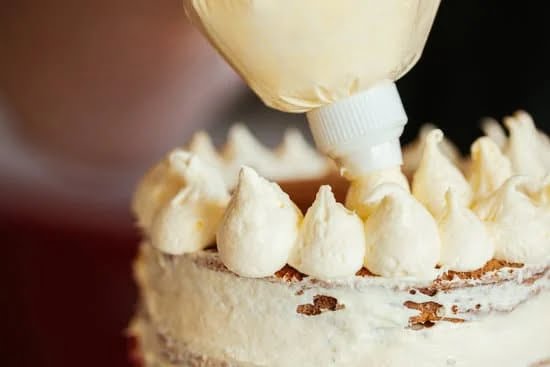Are you tired of spending hours carefully decorating a cake only to realize that something went wrong? In this article, we will explore the common cake decorating mistakes and provide helpful tips on how to fix them. Whether it’s uneven frosting, cracks in the fondant, or piping errors, we’ve got you covered with solutions to make your cake look as good as new.
Before we can fix any cake decorating mishaps, it’s essential to understand what went wrong in the first place. By identifying and assessing the mistake, you can determine the best course of action to take in order to repair the issue. From there, we can delve into specific techniques for smoothing out uneven frosting, covering up cracks and tears, correcting piping errors, repairing fondant mishaps, and even replacing decorations that didn’t turn out as planned.
With our step-by-step guide and helpful tips, you’ll be equipped with the knowledge and skills to address and fix any cake decorating mistakes that may arise. Additionally, we’ll provide valuable insights on how to prevent future mishaps so that you can continue honing your cake decorating skills with confidence. So let’s dive in and start mastering the art of fixing cake decorating mistakes.
Assessing the Mistake
When it comes to cake decorating, mistakes are bound to happen from time to time. Whether it’s uneven frosting, cracks in the cake, piping errors, or fondant mishaps, identifying what went wrong in the decorating process is the first step to fixing these common issues. Assessing the mistake and understanding the root cause can help in finding the most effective solution.
One common mistake in cake decorating is uneven frosting. This can happen when the cake layers are not evenly stacked, resulting in an uneven surface for frosting. To fix this, one trick is to apply a crumb coat first and let it set before applying the final layer of frosting. Another tip is to use a bench scraper or offset spatula for smoothing out the frosting and achieving an even surface.
Another issue that may arise is cracks and tears in the cake’s surface. These imperfections can be hidden by using additional decorations such as fresh fruit, edible flowers, or sprinkles. Fixing these flaws can also be done by strategically placing additional frosting or fondant over the damaged areas.
In order to prevent future mistakes when it comes to cake decorating, it’s important to learn from past errors. Practice makes perfect, and with each mishap comes an opportunity to improve your skills for future cake decorating endeavors.
| Cake Decorating Mistakes | Fixing Tips |
|---|---|
| Uneven Frosting | Apply crumb coat before final frosting layer |
| Cracks and Tears | Hide with additional decorations or add more frosting/fondant |
| Preventing Future Mistakes | Learn from past errors and keep practicing |
Fixing Uneven Frosting
When decorating a cake, one of the most common mistakes is ending up with uneven frosting. This can happen for a variety of reasons, such as not spreading the frosting evenly, using too much pressure in some areas, or not letting the cake cool completely before applying the frosting. However, there are several ways to fix this issue and achieve a smooth and professional-looking finish.
To fix uneven frosting, start by using a bench scraper or offset spatula to gently scrape off the excess frosting. Then, apply a thin layer of fresh frosting over the entire cake to create an even base. Use a rotating cake stand if available to help ensure an even application.
Another technique for smoothing out uneven frosting is to use a Viva paper towel or parchment paper. Place the paper over the frosted surface and gently smooth it out with your hands or a fondant smoother. This will help to even out any bumps or imperfections in the frosting.
If you’re dealing with particularly stubborn uneven spots, try dipping an offset spatula into hot water, wiping off the excess, and then using it to smooth out those areas. The heat from the spatula will help to soften and spread the frosting more easily.
| Fixing Uneven Frosting Techniques | Benefits |
|---|---|
| Using bench scraper or offset spatula | Helps gently remove excess frosting and create an even base |
| Using Viva paper towel or parchment paper | Smoothes out bumps and imperfections in the frosting |
| Using heated offset spatula | Softens and spreads stubborn uneven spots more easily |
Covering Up Cracks and Tears
Cake decorating mistakes can happen to even the most experienced bakers, but there are effective ways to fix these mishaps and still present a beautiful and delicious cake. One of the most common issues that arise during cake decorating is cracks and tears in the cake’s surface, which can be especially frustrating after putting in so much effort to create a masterpiece. Fortunately, there are techniques that can help hide these imperfections and salvage the appearance of the cake.
Using Additional Frosting or Icing
One simple way to cover up cracks and tears in a cake’s surface is to use extra frosting or icing. This method works best for small imperfections, as you can carefully apply a little more frosting over the area and then use a spatula or offset icing smoother to blend it seamlessly with the rest of the cake. Be sure to take your time and make light, gentle movements to avoid damaging the cake further.
Strategic Decorations
Another effective technique for hiding imperfections in a cake’s surface is to strategically place decorations over the problem areas. For example, if there is a crack on one side of the cake, consider adding an extra swirl of frosting, edible flowers, or other decorative elements to that specific area. This not only camouflages the imperfection but also adds visual interest to the overall design of the cake.
Working With Fondant
If you are working with fondant and encounter tears or wrinkles on the cake’s surface, don’t panic. One way to fix this issue is by using a small amount of water on a clean brush or fingertip to smooth out minor tears or seams in fondant.
For larger tears, you can gently press down on the edges of the tear while smoothing it out with your fingers. If necessary, use a small tool like a fondant smoother or sculpting tool for more precision.
These techniques offer practical solutions for handling cracks and tears in cake decoration while maintaining an impeccable presentation. By implementing these methods, bakers can confidently fix mistakes without compromising the overall look and appeal of their cakes. Remember that practice makes perfect; so keep working on your skills and continue learning from each decorating experience.
Correcting Piping Errors
Piping errors can be a common cake decorating mistake, but they are also easily fixable with the right techniques. Whether your piping has come out uneven, crooked, or smudged, there are several ways to correct these mistakes and achieve a professional-looking finish on your cake.
1. Assess the mistake: Before you start fixing the piping error, take a step back and assess what went wrong. Did your hand slip? Was the pressure too high or too low? Identifying the root cause of the mistake will help you avoid making the same error in the future.
2. Fixing uneven piping: If your piping lines came out uneven or wobbly, one way to fix this is by using a small spatula or knife to gently scrape off the uneven parts of the icing. Then, re-pipe over the scraped area using steady and even pressure to create smooth lines.
3. Covering smudged piping: In case you accidentally smudged some of your piping while working on other parts of the cake, you can cover it up by strategically adding extra decorations or embellishments around that area. For example, if there’s a smudge on a flower piped with buttercream icing, consider placing an edible pearl in its center to hide the imperfection.
4. Revisiting tricky spots: If there are areas where multiple pipes converge and create a messy intersection point, carefully go back with a sharp tool like a toothpick or a clean brush to redefine the edges and make them look seamless.
Overall, correcting piping errors requires patience and precision. By following these steps and taking your time to carefully fix any mistakes, you can achieve flawless results on your cake decorating projects.
Remember that practice makes perfect when it comes to cake decorating; don’t be discouraged by mishaps along the way. With time and experience, you’ll become more confident in addressing and avoiding these mistakes altogether.
Repairing Fondant Mishaps
Fondant is a popular choice for cake decorating due to its smooth, polished finish and versatility. However, working with fondant can be tricky, and mistakes such as tears and wrinkles can occur during the decorating process. Fortunately, there are several solutions for fixing these mishaps and salvaging the appearance of your cake.
One common issue when working with fondant is tears or rips that can occur while draping it over the cake. To fix this, you can gently press the tear back together using a small amount of water as adhesive. Smooth out any wrinkles or creases with your fingers or a fondant smoother tool. If the tear is extensive, consider covering it with decorative elements such as edible flowers or buttercream piping to camouflage the imperfection.
Another challenge when working with fondant is wrinkles that may form on the surface of the cake. To address this issue, gently lift the affected area of fondant and use a small brush to apply a tiny amount of water underneath. Smooth out the wrinkled section with your fingers or a fondant smoother tool, working from the center towards the edges to release any trapped air pockets.
If you find that your fondant has developed cracks after application, you can use a small amount of vegetable shortening to fill in and smooth out these imperfections. Rub a tiny bit of shortening onto your fingertips and gently massage it into the crack until it blends seamlessly with the surrounding fondant. Be careful not to use too much shortening, as it can make the fondant too greasy and cause further issues.
Replacing Decorations
Decorating a cake can be a fun and creative process, but sometimes things don’t turn out as planned. Whether it’s a misplaced decoration, a smudged design, or an unexpected mishap with the frosting, there are ways to fix cake decorating mistakes and still end up with a beautiful result. In this section, we will explore how to replace or adjust cake decorations that didn’t turn out as planned.
One common mistake in cake decorating is placing decorations in the wrong spot or realizing that they don’t look quite right once they are on the cake. If this happens, don’t panic. One way to fix this mistake is by carefully removing the decoration using a small offset spatula or toothpick.
Be gentle to avoid damaging the frosting or fondant underneath. Once removed, you can either replace it with a new decoration or adjust its placement to create a more balanced look.
In some cases, decorations may not adhere properly to the cake due to an incorrect method of attachment. If you find that your decorations are starting to fall off or slide down the sides of the cake, consider using edible glue or royal icing to secure them in place. These options provide strong adhesion without affecting the taste of the cake.
By carefully reattaching the decorations using these methods, you can ensure that they stay put and enhance the overall appearance of your cake. With these tips and tricks, fixing cake decorating mistakes related to replacing decorations becomes simpler and less stressful.
Preventing Future Mistakes
Use the Right Tools and Equipment
One of the most common causes of cake decorating mistakes is using the wrong tools or equipment. Ensure that you have a good-quality turntable for frosting and a variety of piping tips for different designs. Invest in high-quality offset spatulas and fondant smoothers to achieve a professional finish. Having the right tools can make a world of difference in your cake decorating process.
Practice Makes Perfect
Just like any other skill, practice is essential for improving your cake decorating abilities. Set aside time to experiment with different techniques and designs, and don’t be discouraged by initial mistakes. The more you practice, the more confident and skilled you’ll become in decorating cakes. Consider taking a cake decorating class or watching online tutorials for additional guidance.
Pay Attention to Temperature and Humidity
Temperature and humidity can greatly affect the outcome of your cake decorating endeavors. Keep your work area cool to prevent frosting from melting or becoming too soft, especially during warmer months. Likewise, extreme dryness can cause fondant to crack and tear, so it’s important to work in a moderately humid environment when working with fondant. Being mindful of these environmental factors can help prevent potential mishaps in the future.
By following these tips, you can avoid some of the most common cake decorating mistakes and improve your skills over time. Remember that patience and perseverance are key when it comes to perfecting the art of cake decoration.
Conclusion
In conclusion, it’s normal for cake decorating mistakes to happen, but the good news is that many of them can be fixed with a little patience and know-how. Whether it’s uneven frosting, cracks in the cake, piping errors, fondant mishaps, or decorations that didn’t turn out as planned, there are solutions for each of these common issues.
By learning how to fix cake decorating mistakes, you can salvage your baked creations and continue to improve your skills.
Remember that assessing the mistake is the first step in finding a solution. Identifying what went wrong in the decorating process will help you determine the best course of action to take. From smoothing out uneven frosting to hiding imperfections in the cake’s surface and fixing piping errors, there are tips and techniques that can help you correct these issues.
It’s important to keep practicing your cake decorating skills and to not be discouraged by mistakes. With time and experience, you’ll become more adept at handling any mishaps that arise during the decorating process. And by following the tips for preventing future mistakes, you can also minimize the chances of encountering these issues in your future baking endeavors. So keep experimenting, keep learning, and keep honing your cake decorating abilities.
Frequently Asked Questions
How Do You Fix Cake Icing Mistakes?
Fixing cake icing mistakes can be challenging, but one way to do so is by using a clean, damp cloth to carefully remove the excess icing. Once the mistake is gone, you can then reapply a smooth layer of icing to cover it up.
How Do You Decorate a Messed Up Cake?
If you have a messed up cake decoration, try to salvage it by adding extra decorations or embellishments that can cover up the mistake. For example, if the piping is uneven, you can add edible flowers or sprinkles to distract from the error and make the cake look more visually appealing.
How Do You Cover Up a Bad Frosting Job?
To cover up a bad frosting job, consider incorporating textured elements like chocolate shavings, nuts, or cookie crumbs around the sides of the cake. This will help disguise any imperfections in the frosting and give your cake a more polished look.
Additionally, adding a decorative border or ribbon around the base of the cake can also hide flaws in the frosting.

Welcome to our cake decorating blog! My name is Destiny Flores, and I am the proud owner of a cake decorating business named Cake Karma. Our mission is to provide delicious, beautiful cakes for all occasions. We specialize in creating custom cakes that are tailored specifically to each customer’s individual needs and tastes.





